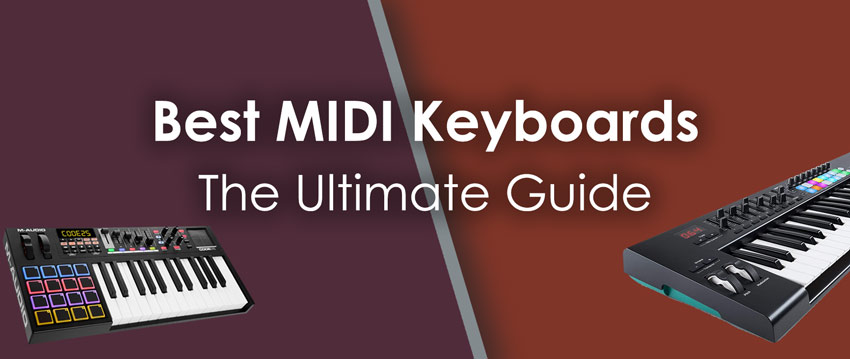
As our website name implies, we focus mainly on pianos, specifically the electronic variants that serve as viable learning and practice tools for all skill levels.
Our most recent article challenged us to pick out a beginner’s training tool for under $150, which was no small feat.
One of the options we offered was a combination of a MIDI Keyboard alongside a VST plugin. This was an interesting take on things, as we’ve yet to cover MIDI keyboards and controllers.
Not long ago we also introduced you to the world of VST plugins and VST instruments in particular. These plugins are ideal companions to the MIDI keyboards we’ll cover in this article.
There’s a lot to consider when it comes to MIDI keyboards, especially since our prior knowledge about companies like Yamaha, Roland, and other prolific digital piano manufacturers don’t apply.
Our Selection Criteria
Unlike our usual lists, we’ll be a bit more lenient with our choices. There won’t be the typical 88 weighted key rule here, because as we just discussed, we aren’t looking for the best piano replacement.
For MIDI keyboards and controllers, we are looking for:
- Good build quality
- Nice-feeling keys (which means it must have keys)
- Pitch-bend and modwheel
- Velocity/pressure sensitivity
That’s a short list due to the important factors you need to consider. At the least, this ensures that any recommendation we make will feel well-built and playable, and you won’t regret your purchase.
However, you’ll need to make a few decisions yourself. Some MIDI controller models come in different keybed sizes, ranging from a miniature 25-keys to the full piano-sized 88, and the models are essentially the same apart from the number of keys.
Hence, you’ll need to judge the following on your own merits:
The preamble is out of the way, you now have an idea about how MIDI controllers work, so let’s look at our top picks.
Arturia KeyStep – Best Portable MIDI Keyboard (25- to 32-key)
Arturia made a name for itself as one of the top developers for software emulations of classic synthesizers. They then moved onto hardware with their highly successful Minibrute synthesizer, praised for its solid build quality and excellent sounds.
Arturia’s focus on expanding its product line was what brought around the KeyStep. This is a portable MIDI controller geared towards laptop-based users who are consistently on the go.
This category is dominated by mini-keys, more likely associated with toys over fully-fledged instruments.
Most people may see recommendations for the ever-popular Akai MPK Mini, or even the Novation Launchkey Mini, both well-reviewed MIDI controllers.
However, the KeyStep wins simply because of how good it feels. The keys, while small, feel a lot more premium, and have a decent amount of travel and springiness.
When compared to the alternatives, there is no competition. The MPK Mini and Launchkey Mini feel cheap and unresponsive, whereas the KeyStep legitimately feels like a real keyboard.
32 keys isn’t a lot, but it’s still better than the 25-keys offered up by the competitors. It’s also important to remember that these are meant to fit into laptop bags. Size and weight must be kept at a minimum here.
If you want a point of reference, I’d say the KeyStep feels like a good unweighted arranger keyboard. That’s not much of an endorsement but believe me when I say there isn’t much better at this size.
The KeyStep was also designed with full-on connectivity in mind, and it shows in the number of options on offer.
USB MIDI is the obvious one, but 5-pin MIDI and even CV/Gate voltage signals are provided. If you’re using legacy gear or modular synth modules, the KeyStep has you covered.
Build quality is also best-in-class here. The KeyStep is plastic, but feels sturdy and is well suited for rugged laptop bags. The knobs and buttons feel much better than the competition.
Where it falters is in the lack of controls. The pitch bend and mod wheel exist as touch strips, which I feel is much better than the MPK Mini’s joystick and the Launchkey Mini’s nothing (though the new MK3 includes touch strips as well).
That’s the limit of positives for controls. The onboard knobs are all used for the sequencer and arpeggiator functions (which are robust for such a compact package), and the buttons are for transport controls only.
Pads are also notably absent, though neither the Launchkey nor the MPK Mini’s pads feel especially good.
While you won’t go wrong with the KeyStep, I would suggest testing out alternatives if given the chance. The Launchkey Mini might be worth it if you’re using Ableton Live as your main DAW.
- Best compact mini keys on the market
- Good build quality
- 5-pin MIDI and CV/Gate support
- Lack of knobs and buttons
Alternatives
We talked briefly about the MPK Mini and the Launchkey Mini above. We don’t consider them viable controllers, but you can always try their bigger counterparts, the Akai MPK225 and Launchkey 25.
These dodge the problem of mini keys, but I still give the KeyStep the edge in that regard. The good controls are even more prominent here though and might just push you over the edge.
You could also consider the Arturia MiniLab, an even more miniaturized variation of the Arturia formula, but it has knobs and pads at the cost of 5-pin MIDI and CV.
This is a purely computer-based solution, but it still feels far superior to the competition.
Nektar SE49 – Best Budget MIDI Keyboard (below $200)
While the Arturia KeyStep is great, it’s not something I’ll use for playing complex parts like chords or piano pieces. The 32-key limit means I have only 2.5 octaves to work with, which is extremely limiting.
That’s why we recommend the Nektar SE49. 49 keys aren’t a lot either, but Nektar more than makes up for it with their playability and simple control scheme.
Nektar as a company was founded to make MIDI controllers that closely integrated with DAWs, specifically Reason, giving you the ideal experience of being able to operate without even glancing at your computer screen.
This laser focus lends itself to specific DAW audiences but is not ideal for a general consumer. Thankfully, Nektar excels at good keyboards, and that same level of quality is seen with the SE49.
It’s worth noting that this category is highly contested. The Roland A-49 is a slightly more expensive option that’s a bit older, but it is well praised for offering good value for money.
The M-Audio Keystation series, on the other hand, lags in terms of playability but features 5-pin MIDI support.
In fact, that’s the first blow against the SE49. You’re operating strictly on USB MIDI here. If you’ve got MIDI modules in mind, you might want to consider the Keystation.
Apart from that, the SE49 is plagued by the absence of more controls. A fader, pitch and mod wheels, and 4 buttons (which double as octave switchers) are all you get. And again, no pads – yikes!
However, the SE49 makes up for this by including one of the best unweighted keyboards I’ve played. Only the semi-weighted keys on the Novation Impulse (which costs 4 times more) beats it.
In my opinion, this beats out other options in this price range by simply feeling the best. I can play piano, synth, and organ on the SE49 without much issue.
The Keystation falters on account of its weak keybed, and while the Roland A-49 feels good with synths, it doesn’t feel as good with glides and glissandos.
The only thing that would have made the SE49’s keys perfect would be aftertouch, but it straight up doesn’t exist with the competitors at this price point, so I won’t hold it against Nektar.
Even the controls, limited as they are, feel high-quality. The pitch bend and mod wheels feel very precise despite their cheap look, which was unexpected.
Even the Keystation 49 costs more, and I’d argue that it’s a worse deal unless you desperately require 5-pin MIDI. Seriously, go with the SE49. As far as price to performance ratios go, this is tough to beat.
- Great keybed for the price
- Very affordable
- Decent build quality
- USB MIDI only
- No aftertouch
- Lack of controls
Alternatives
In terms of alternatives, the Keystation series as well as the Oxygen line (if you need more controls) have variants with more keys, which might make it seem like the obvious choice if more keys are needed.
However, Nektar also makes the Impact GX61, which is cheaper than the Keystation 61 while featuring an upgraded build quality over the SE49.
Alternatively, if you’re willing to spend more, I recommend checking out the M-Audio Code series and the Novation Launchkey series (non-mini versions). These are all well-praised options that justify the extra price, giving you aftertouch, semi-weighted keys, and so on.
Arturia KeyLab MKII – Best Controls
We’ve been skimping on excess controls so far, which seems counterintuitive to the design of MIDI controllers. However, we stand by the fact that keys are the most important aspect of any keyboard.
Regardless, for people who want a lot of knobs and buttons, the Arturia Keylab is the way to go. We’ve already introduced Arturia, so you know their pedigree as one of the top names in computer music.
The KeyLab series is split into the mainline series (KeyLab 49, 61, and 88 which is weighted) and the Essential series (KeyLab Essential 49 and 61).
The differences primarily regard the layout and the Essential line’s reduced number of controls. We’ll consider the series, but our opinions will be based on the KeyLab 49 MKII, which we believe is a better option.
The KeyLab takes the KeyStep design ethos and cranks it up to eleven. You get the same robust build quality with bonus wooden sides, a full-sized keybed, and actual controls beyond the transport buttons.
The keybed itself feels good and roughly identical regardless of which model you choose. Considering Arturia managed to make good on a mini-sized keyboard, I’m not surprised that their fully-grown brethren excel, too.
The keys here feel great and are a great fit for any playstyle once you’ve gotten used to them.
The KeyLab 88 is the only exception, featuring an ungraded piano-style weighted keyboard. While I did find it good, I think there are better options out there.
Even the FP-30 (which admittedly features Roland’s PHA-4 Standard action) feels better despite a much lower cost.

Arturia KeyLab 61 MKII (white version)
Everything here feels physically sound. The pitch and mod wheels are physical and have a light response and quick return time that feels somewhat like the Nord-style keyboards many of us covet.
Pads are also included (4×4 matrix on the mainline, and 4×2 on the Essential). The pads are less Akai MPC-style resistant, and more like the Native Instrument’s Maschine-style responsiveness.
This is a personal preference, but I find myself enjoying these a lot more than those on the Akai MIDI keyboards.
The faders, knobs, and buttons feel like they came off real hardware mixing boards, and there’s even a simple LCD screen to provide visual feedback when necessary.
The magic with the LCD screen is that the KeyLab comes with preset configurations for well-known DAWs and hardware synthesizers.
No matter what DAW you use (apart from FL Studio, which feels like a weird omission considering its popularity), there’s a default setup you can use and modify to taste. Arturia even provides printed labels you can use to change the button descriptors.
Since you have MIDI and CV/Gate connections, you can also use preset configurations with most hardware synthesizers, modern or otherwise.
Using this with the Prophet 6 available in the store was seamless, and I saw a lot of recognizable names in the menus.
Overall, I’d say the KeyLab is the best in its class. While some might consider the price to be a negative, there are many worse keyboards that cost more, and you really are getting a lot more than you pay for.
- Full connectivity options provided
- Good keys and controls
- Versatile configuration with provided presets
- Slightly higher price
Alternatives
For a higher price, you can get the Novation SL MKIII-series keyboards, designed specifically with Ableton Live in mind, integrating its 8×2 pad matrix and multiple color-LCD screens with the workflow directly.
While I love the SL MKIII as an Ableton Live user, it doesn’t integrate as well with other software and hardware. I’ll still note it down here as an excellent choice though.
The AKAI MPK249/261, Novation Launchkey, and the Nektar Impact LX series are MIDI keyboards available at a cheaper price, and they’re solid choices if the KeyLab feels too expensive.
I personally favor the Impact LX over the other two, but Akai is known for making sturdy products that last a long time.
These options aren’t exactly excellent, but they offer a good amount of controls for the price. The KeyLab is slightly ahead when it comes to playability and integration.
Novation Impulse – Best Semi-Weighted MIDI Controller
Novation is another veteran MIDI controller. Their earliest controllers focused on providing as much control as possible. In fact, the ‘father of controllerism’ Moldover himself began by heavily modifying one of the earliest Novation SL keyboards to make his dreams of complete control a reality.
Novation is most well-known for its Launchpad line, which featured simple 8×8 pad controllers made for sample triggering, and these were surprisingly successful for performance purposes.
Many now write off Novation as just ‘the Launchpad company,’ but their legacy speaks for itself. They know what people want and they’re good at making things that work well.
We already spoke briefly about the latest MKIII SL iteration, but that’s not the only product to consider.
The Novation Impulse is an old MIDI controller, but the keyboard is one of the best I’ve played, and it even comes close to surpassing the semi-weighted 73-key variation of the Nord Stage 3.
Let’s talk about the keys first. They are semi-weighted and come in 25-61 key variations. The 61-key model is the one we’ll refer to.
Basically, semi-weighted keys feel somewhat like light piano keys, making them a happy medium between weighted and synth-action keys.
I personally prefer them over straight-up unweighted keys because of their versatility. Being able to play both piano and synth parts convincingly without changing your technique is quite useful, as you won’t need to switch between controllers just to get your ideas out.
The keys here are still the best semi-weighted keys I’ve played, despite being released in 2012, and I still recommend them. Velocity response and aftertouch are good, though aftertouch feels slightly uneven on the black keys.
Either way, keys aren’t the Impulse’s only advantage. There is a good amount of controls here such as pads, faders, and buttons, which unfortunately feel less premium due to their age. The SL does have the edge here, especially in terms of integration.
However, Novation’s built-in Automap software works well enough for most plugins and DAWs, though some of the more recent plugins aren’t supported.
Most of the common ones are still used to this day though, and I didn’t find many failures while using it.
As you’ve probably noted throughout this article, controls take a back seat to good keys for us. The Impulse is a great keyboard at a good price, and one might even call it a good ‘impulse’ buy, pun intended.
- One of the best semi-weighted keyboards available
- All the controls you need
- Everything apart from the keyboard feels a bit dated
Alternatives
There’s a better option if you’re willing to sacrifice a lot of controls and pay a lot more. Native Instruments is the biggest name in the business, and their plugins and hardware integrate well with each other.
Their new Komplete Kontrol S series includes semi-weighted keyboards courtesy of Fatar.
If that name sounds familiar, it’s because they’re responsible for the keys on all Nord keyboards, as well as the new up and coming company Dexibell.
The 49- and 61-key variants of the Komplete Control (henceforth known as the S49 and S61) are virtual carbon-copies of the Nord Stage 3 73’s semi-weighted keyboard, and I have to say they’re hard to beat.
These keyboards also include a high-resolution OLED display that gives you direct control of NKS supported plugins, something no other MIDI controller can attest.
The only major downsides to this keyboard are a hefty price and a limited number of controls. Even so, the screen + knob combination is efficient and hampered only by a lack of full-fledged support from non-Native Instruments plugins.
Kawai VPC1 – Best Weighted Keys
Kawai needs no introduction as prolific acoustic and digital piano makers, having been around since 1927.
For the longest time, people resorted to actual digital pianos for that accurate replication of feel. Options like the Akai MPK88 existed but never compared to the more professional touch of actual digital pianos.
While getting an affordable yet well-reviewed digital piano (such as the excellent FP-30) is a valid option, you need to pay top dollar for wooden keys and responsive sensors. Kawai’s VPC1 felt like the natural answer to that problem.
The VPC1 is the most limited MIDI controller on this list, as there isn’t much to work with in terms of controls. You get a power button, USB MIDI and 5-pin connections, and the full-sized 88-key keyboard.
No faders, no buttons, nothing at all. This might seem blasphemous, but you’d be surprised to find that companies like Akai and M-Audio are attempting to recreate this minimalist product with their own Akai Road 88 and the M-Audio Hammer.
Sadly, they don’t come close. The Kawai VPC1 has the best keyboard of the bunch and is worth the price of admission.
If you look up the price, breathe deeply. Over $1,000 seems like a lot until you realize you’re getting the RM3II wooden key action.
These keys are far from plastic blocks and compare to the Grand Feel key actions featured on Kawai’s flagship console-style digital pianos (which cost many times more).
With the RM3II action, you get a simulated acoustic feel with graded hammers, counterweights on keys, synthetic ivory-textured surfaces, and triple sensor detection for repetitive key presses.
A triple pedal setup also comes with the controller, providing soft, sostenuto, and damper pedaling in one package. As with Kawai’s digital pianos, these feel realistic and support half-damper functionality.
You even get to customize your own velocity curves using the VPC editor software.
This is the best piano-style weighted key action you can get in a MIDI controller. The competition (especially the Akai Road) comes close, but it’s not worth saving if you want the closest to the real deal.
More so than anywhere else, you’ll need to pair this with a good software piano. Again, I recommend you check out our breakdown of all our top piano VST plugins to find one that works best for you.
- Best fully weighted key action on a non-digital piano
- Excellent build quality
- Piano-style design
- Price
- Relatively heavy
- No controls
Alternatives
While the Akai Road 88 seems enticing due to costing 3/4 of the price, I’d say the M-Audio Hammer or the Studiologic SL88 Grand is a better value-for-money option.
The latter comes with Fatar’s premium TP/40 Wood action, which feels superior to the SL88 Studio with a lighter and more basic action, the TP/100LR.
The actions still feel worse than Kawai’s RM3II, but they have a few bonuses that justify the downgrade.
It also helps that they cost less than half the price of the Kawai VPC1.
Roli Seaboard – Best Innovation
If there’s one takeaway from this whole article, it’s that MIDI controllers are all about giving the user control.
Knobs, buttons, and faders seem archaic, but they’re an easy method for interacting with sound parameters to add expressivity.
However, those feel more like an engineer’s tool, as opposed to that of a musician. Roli is a company formed to tackle that issue head-on. Their products, from the Roli Lightpad Block to the Roli Seaboard, don’t have knobs or buttons.
Instead, they use the simple concept of aftertouch and add extra dimensions to enhance performance capabilities.
Imagine controlling a synthesizer’s filter cutoff point by moving your finger up and down the keys. Perhaps even controlling pitch bend by moving your fingers horizontally!
This is all possible with the Seaboard, and it’s something quite unique. If you’ve ever used Korg’s famous Kaoss pads, this feels like that, but in keyboard form.
Touch is the name of the game here, and Roli even designed their own software plugins to take full advantage of their keyboard. These come with every Seaboard model you can buy, and while they’re complicated, the sounds are worth the effort.
The problem here is the price. The cheapest Seaboard Block is many times the price of other 25-key controllers, and the Seaboard Rise 49-key variant costs nearly as much as the Kawai VPC1! That’s no small investment.
However, this is innovation the way we like it. It’s hard to say how things will change in the coming years, but we’re looking forward to more innovative products like the Seaboard from other companies.
Honorable Mentions
The Roli Seaboard requires you to significantly alter your playstyle, so what if you like your current keyboard?
Well, a lot of other products act as accessories to enhance performance, rather than replace your current rig. These include the ring-based MIDI controller from Enhancia that reacts to movement dynamically, sending CC changes as you move your hands.
On paper, this seems less cool than the Seaboard, but it might be worth looking into if you’re hitting a creative wall in your performances and want to spice things up.
Are MIDI Keyboards a Valid Replacement to Digital Pianos?
MIDI keyboards are valid practice tools for budding pianists and keyboardists. While the setup may turn some away, the cheaper price is a bargain. We won’t get detailed here, but you can make it work.
Our stance remains, if you want to learn the piano specifically, you need a good set of realistic keys and sounds. MIDI keyboards aren’t suited for this goal.
So, if your goal is to become a pianist, I’d suggest going with some of the selections from our other lists. Weighted MIDI keyboards exist (as we’ll cover below), but they’re expensive and don’t offer any sounds.
Sustain Pedals
Sustain pedals are omitted on all but the Kawai VPC1, so you’ll need to shell out a bit more cash to unlock full functionality. Something worth considering when purchasing pedals for MIDI controllers is whether you require half-pedaling.
Pedals with half-damper support cost a bit more but are well worth the extra price to enhance realism on supporting plugins like Keyscape.
Our favorite damper pedal that supports half-pedaling (and our favorite sustain pedal in general) is Korg’s DS-1H. This small pedal is built like a tank and will last you many years even if you chuck it around.
It’s also not a square block-style pedal, which is something we prefer. The DS-1H feels good, with a decent amount of resistance so you can rest atop it, but not so much that you’ll struggle to push downwards.
If you decide that half-pedaling is unnecessary, your options open greatly. We recommend the Nektar NP-2 for its cheap price and good build quality. The M-Audio SP-2 is a good alternative as well.
Final Words
MIDI controllers are interesting if you’re willing to dive deep, and I hope we’ve given you an idea of what to look for. If you’ve gotten this far, I want to strongly recommend you consider your main purposes.
While we stand by our stance that keys are the most important aspect, there are other factors to consider.
You’re not limited to single products when it comes to controllers, and as we said early on, the sky is the limit. As always, we recommend going into stores to test out your purchases beforehand whenever possible. A good feel is something we always look for and being subjective means that what we like might not be your personal favorite.
Regardless, we hope you’ve enjoyed this breakdown of MIDI controllers. If you want to know more about piano VSTs and plugins, we invite you to review our previous coverage for a pro’s thoughts on the matter.
You might also like:
The Ultimate Guide to Buying a Digital Piano
Best DAWs Today: How to Choose Your First DAW?
Best Studio Monitors: The Ultimate Buying Guide



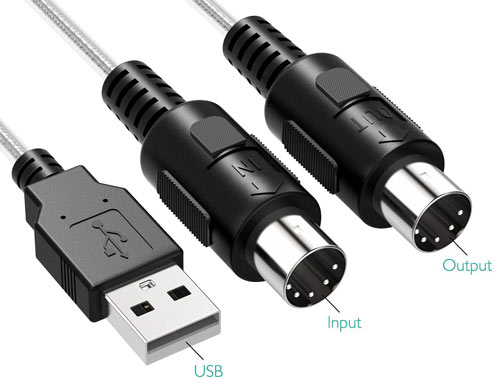
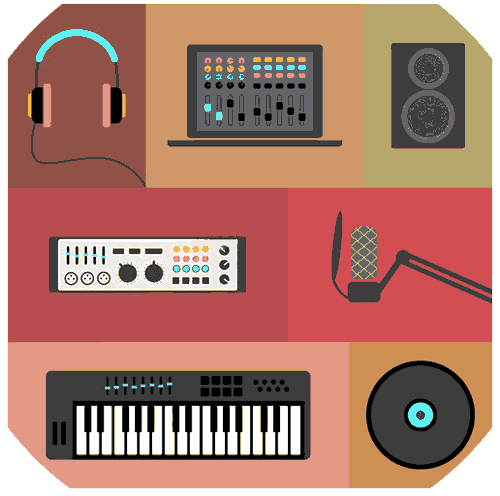



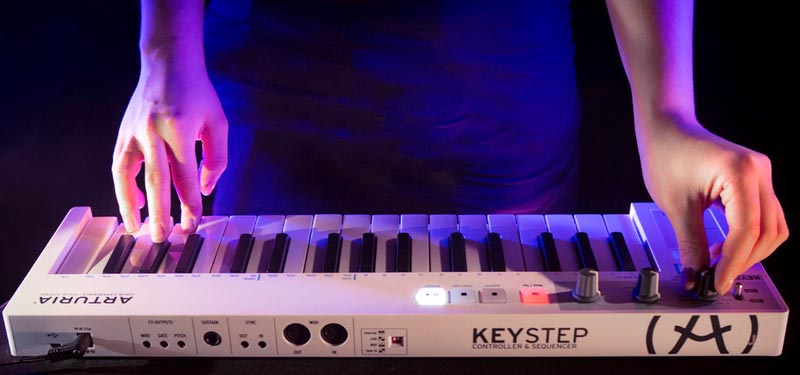

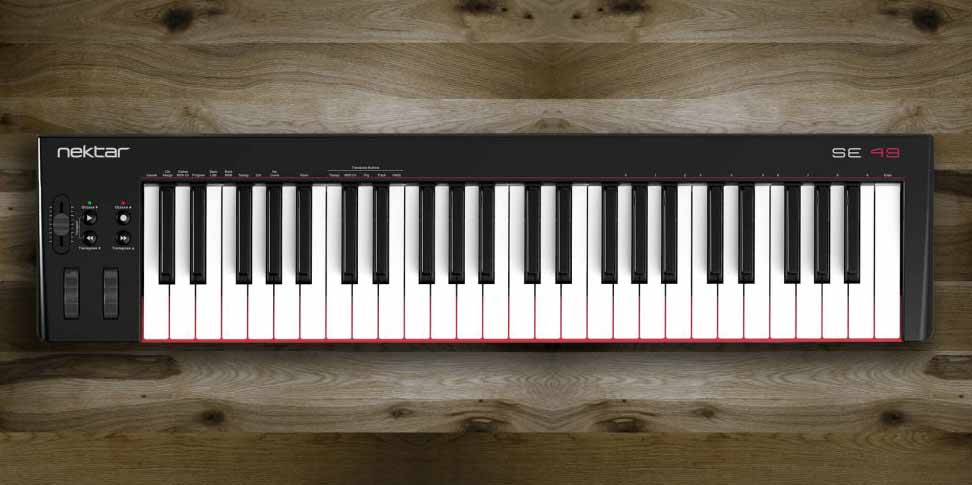

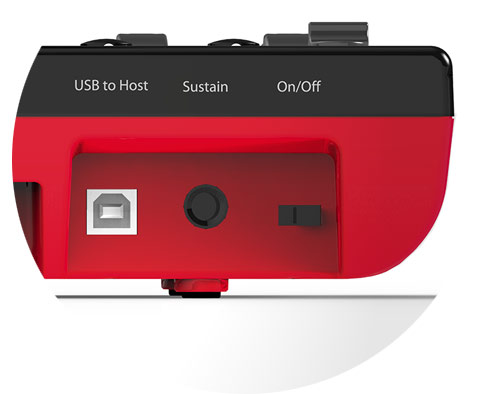

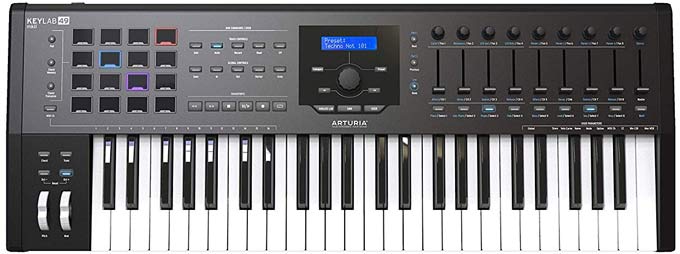




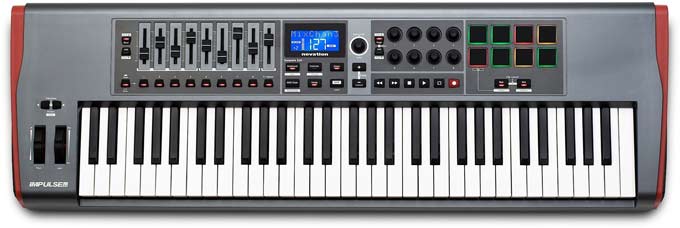
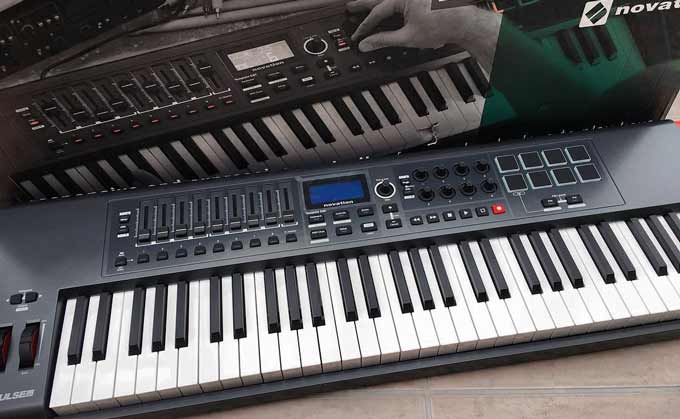





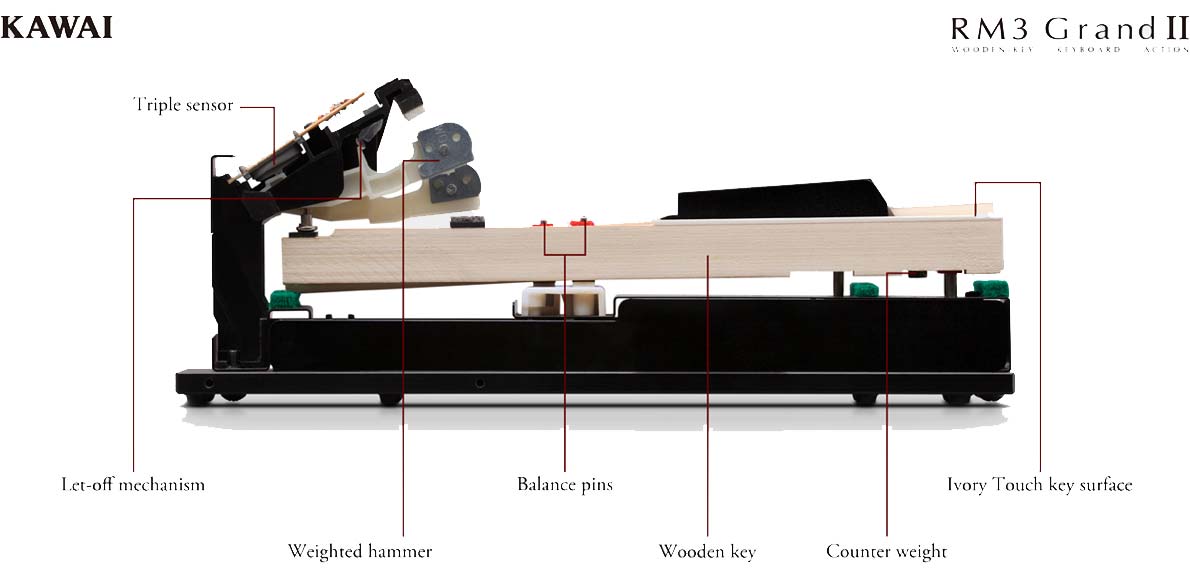

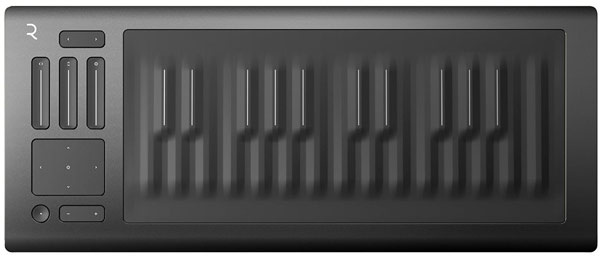



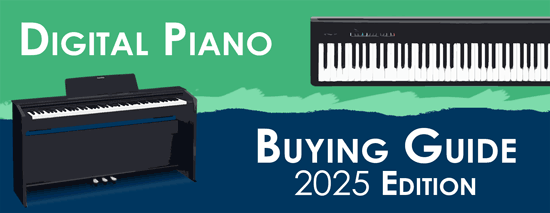


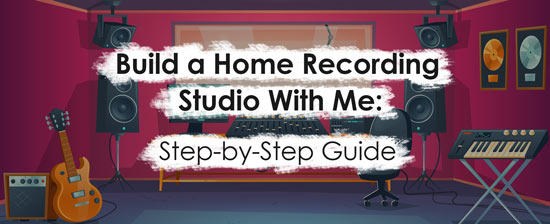
Thank you for a great article. I have a question though: I there a way to use some other hardware instead of a computer to play with a midi controller? Thank you for the answer!
Hi Adam, thanks for your question. Sure, you can use an iPad or your smartphone, though it wouldn’t be as convenient as using a computer. Plus, sample libraries available for mobile devices usually have a reduced size compared to full-fledged VST plugins available for computers. With that said, you can still find a lot of cool apps to play around with different sounds and effects. Garage Band would be a great way to start.
I use a Roland RD-2000 live and I’m looking to add a 2nd keyboard for organ and some synth work. I use MainStage for my organ sounds and I’d like a keyboard that would allow me to use the faders as drawbars. I was considering a Novation SL MKiii, but it only has 8 faders, so I’m now looking at the Arturia Keylab Mkii. Can you comment if there is really that big of a difference between the two in terms of performance and, given that I have an 88 note keyboard, if I could get away with the 49-key model of either. Thanks.
Hi Lee,
I’d personally recommend going with the Arturia Keylab MkII. The Novation SL MkIII is a great keyboard, but it’s more heavily geared towards Ableton Live users. If you do end up getting the Novation, you’re spending a lot for features like pad-based session clip triggering, and the LED screen which you can’t fully utilize on Mainstage. The Keylab’s faders might not feel like real drawbars, but there aren’t any real options that come close.
Since you’re after keyboards with faders, you could also consider the Akai MPK249/61, which is a cheaper option that has a good keybed and decent faders, among other extras that make it well worth the investment. If you manage to find one, the last-generation Akai MPK49/61 is also good and features what I consider to be the better faders.
Alternatively, you could consider a MIDI mixer controller, like Novation’s LaunchControl or the Akai MIDImix. These don’t have keys, but they’re a nice way of expanding your current setup without spending too much. Though, I will say that these faders are geared towards mixing and DJs, so they aren’t as good with performances. If you are interested, the Akai APC40 (both current and last-generation) features some of the best faders I’ve tried on mixing controllers, so it’s worth considering despite being yet another Ableton Live-focused controller.
Thank you for your informative site! I love the information you present and your wonderful style.
I am looking for a 88 key controller, but a piano feel is most important to me, so I am considering the Casio Privia PX-S1000 instead of a controller (which I tested at my local store today and really liked!) I was also considering a StudioLogic SL88 and Arturia Keylab 88 MKII, but I haven’t found a local source to feel the keys.
Do you have a recommendation?
Hi Addi,
Well, if you don’t need all those controls for manipulating the sound on the fly, then a digital piano would probably make more sense in your case than a MIDI controller. MIDI controllers you mentioned are great controllers, but when it comes to piano feel, I wouldn’t expect too much realism from them.
The StudioLogic SL88 Studio and Arturia Keylab 88 MKII share the same key action, the Fatar TP/100LR, which I’m not a big fan of if realistic feel is important. The Studiologic SL88 Grand uses a better key action, the Fatar TP/40 wood graded hammer action, but it’s also much more expensive.
All in all, there are more affordable digital pianos that feel just as good or better than the mentioned controllers. Plus, it’s great that you were able to try out the PX-S1000. I would encourage you to play a few other models in the same price range to see if there’s something you like even better.
Hi Lucas.
Thanks for the great article. I am looking for a light and cheap 61 key solution for beginner practicing piano during holidays with a VST piano. At home I have a Casio PX-S1000.
On my shortlist are:
Casiotone CT-S300 (as Midi Controller during vacation and kids instrument at home),
Nektar GX61,
M Audio Keystation 61 Mk3
Others say the new Mk3 61 keystation would be the best light piano replacement because of the half weighted resistence it offers, allowing better expression playing piano. Would you prefere the GX61 over the Keystation 61 Mk3? How well does the Casiotone hold up for practising piano?
One more thing:
Obviously, the action of the M-Audio Keystation 49 Mk3 and Keystation 61 Mk3 is very different. While the 49 has an unweighted synth-style action, the 61 apparently has a semi-weighted action. Saw this while reading buyer reviews.
Does your statement that the Nektar GX61 is more playable than the Keystation Mk3 refer to the 49 or the 61 key variant?
Hi Tom,
I didn’t spend too much time with the Keystation 61 Mk3, but I strangely didn’t even notice that the keys were semi-weighted. They felt like your typical synth action keys, with a bit more added bulk from the waterfall-shaped keys, so I’d definitely say the GX61 plays better. Calling them semi-weighted seems a bit misleading based on raw feel, as they feel similar to the pseudo-waterfall keys on the Yamaha NP-12 and NP-32, which are just unweighted synth-action keys.
Regarding the Casiotone, I personally liked it quite a bit as a budget practice keyboard. If you want easy access to sounds without the hassle of booting up your laptop/PC, the Casiotone works great.
However, I still put the GX61 a step above in terms of feel. I’m someone who has access to a laptop 24/7, so it’s not a problem for me. Having a good VST plugin and the comfortable keys of the GX61 feels like the best middle ground for cost-saving in my books.
Both the GX61 and the Casiotone work for practice. I guess it all comes down to what you’re personally looking for. Do you want a straightforward experience, or the ability to choose your sounds via software? Either way, you’re getting a solid keyboard.
Hi, Lucas,
I have now ordered and tried the Nektar GX61. Somehow I could not get along with this keyboard very well: The keys made a rattling impression on me and I couldn’t adjust the velocity to suit me despite different curves.
So I ordered the Keystation 61 MK3 after all. And what can I say: Right from the start the feel and the velocity curve was quite good for me.
The GX61 I could return. For the price it was certainly a great keyboard. For piano playing, the M-Audio Keystation 61 MK3 suits me much better. Of course, this is always a question of personal preference and habit.
Thank you & many greetings,
Tom
Hey Tom,
Glad you ultimately found the instrument you’re happy with. Good luck on your musical journey!
I agree. I am enjoying the key action on the M-Audio Keystation 61 MK3 and I appreciate having the 5-PIN MIDI port which is missing from the GX61.
Hi Lucas,
Is the combination of a good midi keyboard with a good piano VST and good speakers a sensible alternative to a digital piano in a comparable price range? My intended use is at home for learning to play the piano, play along/improvise on recorded music (Music Minus One from the days of vinyls comes to my mind but apps probably offer this now as well). My guess is that a Kawai VPC1 with a powerful laptop plus Pianoteq 6 or Vienna Imperial’s Bösendorfer Imperial 290-755 and a DAW plus some learning apps would offer me at least the same realistic keyboard action and functionality as the Yamaha CSP series. Casio and Roland offer probably comparable models. But what about the sound reproduction? Would studio monitors be able to produce a sound that is at par with the sound of a CSP or equivalent of other brands? Or are such digital pianos still ahead in sound reproduction? Could you give a recommendation what speakers/amplification would be worth the Kawai VPC1 plus the above VSTs?
PS: I just started supporting you through Patreon because your website provides quality information. I hope more people will support you as well.
Hi Gernot,
Truly appreciate your support, thank you for your donation!
I would say that a Kawai VPC paired with high-quality piano sounds, like the VSL Vienna Imperial Grand is definitely as good as it gets. If you haven’t already purchased the software, you could also consider Keyscape from Spectrasonics, which is an industry standard key-based library that sounds incredible. This also includes electric pianos, which might help if you want the added versatility.
With regards to monitor speakers, I think that a decent pair of monitor speakers will certainly sound better than built-in speakers on most digital pianos. Monitor speakers are designed to recreate a full-range of frequencies as accurately as their price point allows, and that’s always going to be better than built-in speakers that are limited by space and price concerns.
With that said, your point of comparison was the Yamaha CSP series, which is one of the better sounding digital pianos out there. The speakers on Yamaha’s Clavinova line are tuned to reproduce great piano tones, and I personally think the combined feel of the keys, body and speakers are hard to beat.
If budget is a concern, I’d go with the Kawai + software combo without question. With good monitor speakers (set up correctly in a good room), you’ll have a setup that rivals top tier digital pianos. It’d be nice to have a reference budget to know what types of monitors to recommend.
On the other hand, if all of this sounds like too much of a hassle, I’d go with the digital piano option. Despite my love of MIDI keyboards, I still enjoy the physical sensation of hearing and feeling the vibrations of a digital piano, which adds to the realism factor. This is something slab-based pianos just fail to recreate.
Hi Lucas,
Many thanks for your insights.
In the meantime I was reading about monitors and room acoustics. As monitors I am considering Genelec 8020 or 8030 or Neumann KH 80 DSP. What do you think about these? Would a subwoofer help with realistic sound reproduction? I am also thinking about some absorbers and diffusers to treat the room.
But taking the Kawai VPC1 plus around 1000 € for monitors, we already reach the price of a CSP-150 and still need to add the piano VST, keyboard stand and monitor fixtures/stands and cables. I would find such a setup justified if the sound and feel would be clearly superior to the CSP-150. I regard experimenting with a setup as part of the fun of making music. I have never been in a studio, so I don’t know what to expect from such a solution. Maybe you could give some insight on this?
Good that you mentioned Keyscape, which might better fit my interest in Jazz, Latin, Blues, Rock, Pop, etc.
What I find intriguing about the CSP series is the real-time backing band accompaniment (with the Smart Pianist app). Do other brands offer this as well? If yes, which ones and which product lines? What I don’t like about arranger keyboards is the synthesizer keyboard action. But I do not really know what is on the market in this field. Any advice here is very welcome. I saw there is arranger hardware (e.g. Roland BK-7m) but I could not find any software or apps that react in real-time to what you are playing. I only found solutions where you set up the chord progressions beforehand or chose a song to play along, which is nice as well.
Maybe you could add an article to your website about software/hardware solutions for band backing or provide some advice where to look for.
Judging by your comments thus far, I think getting the CSP-series might be the right choice for you. The cool thing about software is that you can always dabble with it later on, using your Clavinova (or any other keyboard with USB connectivity) as a MIDI controller and speaker. If you want more sounds, the option is always going to be there when you need it.
I haven’t personally tried the CSP-series and its backing band feature, but I am quite intrigued, especially if the quality of the funk style they showed off in their promo video is retained throughout all available styles.
I believe what’s going on is something similar to arranger keyboards, where it tracks your lower register playing to guess or infer the current chord, and modifies the backing tracks to fit in. The samples and instruments being used to make the backing track are quite amazing though, and I think you’ll have a lot of fun with the CSP-150, and you won’t need to worry about the rest of the setup. (That’s actually a problem with a lot of us software freaks, we spend too much time worrying about gear and too little time actually making music).
I will say this, if you really want to make your own songs, these auto accompaniment tools might feel a bit limiting. Say you decide you want to add a few flourishes or sudden stops for tension, it’s practically impossible, as the tracking software only knows what chord you’re playing and how hard you’re playing it. There are other limitations too, like the possibility of missing more complex chords (diminished 7 passing chords for example). Depending on how you play, and what music you listen to, you might find yourself hitting these limitations sooner rather than later.
For me, I love having fun with these features, and I foresee myself wasting a lot of time with the backing band feature if we ever decide to review a supported Clavinova. However, there’s a difference between arranging your song, and playing along to a preset arrangement. It’s one of the reasons I’ve moved away from using preset drum patterns in my own music, as I’d rather make up my own rhythmic progressions before arranging a drumline that fits.
If you do decide to go the software route, there really isn’t a lot that does both real-time chord tracking and full arrangements. I would look into PGMusic’s Band-in-a-Box. I’ll admit that I haven’t used this since 2012, but it was quite impressive even at the time. Its newer RealBand features seem to do what Yamaha’s backing band does, but you might need to check out its demo to see if it matches the sound quality of Yamaha.
Oh, regarding the monitors. I haven’t tried the Nuemann KH 80 DSP but Genelec monitors are considered to be one of the best pro-grade studio monitors out there, so it’s hard to go wrong with them. A subwoofer could help, but again I would listen to the setup without it first to see if it’s even necessary.
I use a pair of KRK Rokit 5 G4’s, and they go down pretty low. They are good for near-field use and I think they make a good representation for the piano sound. They are also cheaper than the Genelecs.
Hi!
I would like to upgrade from the StudioLogic SL88Grand to something with a better action. I’m particularly bothered by the narrower width in the black keys compared with a concert grand.
I’m now debating whether to have the MP11SE or the VPC1. I don’t need internal sound, but I would like the best key action, if possible. I’m more of a heavier-weighted key person, but it should be as heavy as the Yamaha CLP675 or 685 digital pianos. I’ve played on them before, and they are quite fatiguing. I would love it if you have any suggestions. Now that I can’t try out anything due to covid and shipping difficulties, please help me make a decision. Thank you!!!
Hi, I cowrote this article alongside Lucas, so I’ll give my two cents here.
I haven’t tested out the MP11SE yet, but I do own a CLP digital piano, albeit an older one. I’ll admit that the keys are a bit heavier than other digital pianos, but I’ve gotten used to them over time. I feel like their strength lies in how natural they feel. The heftiness is complemented by well-tuned velocity curve that makes things feel very realistic.
In comparison, the VPC feels just as good and natural. It doesn’t have as much weight as the CLP, so don’t worry. I’d say you’ll probably enjoy it, and it’s well worth the price. I tested the VPC with a few VSTs, and when combined with heavyweight libraries having multiple velocity layers, it definitely feels comparable to fully fledged digital pianos.
Considering you don’t need onboard sounds, I’d say the VPC is an easy choice. It’s cheaper, it’s more recent, and the customization you can get through VSTs makes it arguably more versatile too.
Thanks for your input, Shao Ren. Now I can somewhat imagine how the VPC1 would feel like. So it looks like it would register better with my upgrade purposes than the MP11SE just because it doesn’t have internal sounds and the price is good. But I would still like to know, if by getting the MP11SE I would be getting a better and more improved action than the VPC1? Since I can’t have a direct comparison of the two instruments, I will need to trust what you say. I’d love to also hear the other co-auther, Lucas and his opinions, if possible. Thanks again for your efforts!
David
Hey David,
Lucas here. The key action on the VPC1 is definitely on the heavier side but I don’t find it hard to play. The MP11SE has a newer key action of a similar design (you can think of it as the successor to the VPC1’s action). As I recall, it’s a bit lighter and has a slightly different feel (especially further up the keys). But, the difference is not like “day and night”. They are more similar than different feel-wise.
Considering that you don’t need any internal sounds and the price difference between these two models is pretty significant, the VPC1 might actually be a better option in your case. But as always, I recommend testing the instruments out personally whenever possible!
Hi Lucas! Thanks for your reply. I like a heavier action for sure, and yes, I think the VPC1 would have a good advantage price wise, as well as the action being a bit heavier. Hopefully I could find a place to test these out in the midst of the pandemic. Your reply is quite helpful. Thanks again!!!
Hi Lucas,
I have been inclined to acquiring a keyboard, either a Kurzweil Forte SE or a PC4-88, or a Roland FA-08.
Would any of these work well as a Midi controller? I love the warmth of the Roland’s sounds. I read that the Roland FA-08 can work as an interface besides auto-mapping features. However, it does not have aftertouch. Both Kurzweil have aftertouch, but they do not have auto-mapping and the interface features that Roland offers.
The other option I considered was to get a Nektar Impact LX 88 to work with Logic, but I know I will miss the sounds a full keyboard offers.
Finally, would a Roland RD 88 work well enough as a Midi controller?
Thanks!
Hi Sergio, I might not be Lucas, but I did write this article, so I’ll try answering your question.
I haven’t actually done a full-on test of the Kurzweil Forte SE or the PC4-88 (curse regional availability), so I can’t really comment on those. However, I’ve heard good things about their DAW integration via its multi-mode.
On the subject of automapping, its a bit unfortunate that you use Logic, as that’s one of the few DAWs that don’t have convenient assignable MIDI Learn capabilities. However, you can still assign different knobs (that send MIDI CC signals) to different instrument parameters, its just a hassle.
Since its been a while since I used Logic (pandemic means not much studio time), I might be wrong, but under the ‘Control Surfaces’ menu, you should be able to assign different controls to different parameters. Though it is quite a hassle compared to other DAWs like Reason or Live where a simple right click handles everything.
Since I co-wrote the RD-88 review, I can also confirm that it does indeed work as a MIDI controller through it’s ‘DAW Control’ mode. However, I didn’t test it’s Logic Pro mapping as I use a Windows-based system. It did work fine in Ableton Live though, with MIDI Learn assignments being a breeze to set up.
While I’m completely biased as a fan of the FA-08, I think it might be worth considering what plugins or sound sources you intend to use within your DAW or performance software. If aftertouch is an integral part of your performing style, I think the answer is clear. On the other hand, if you’re more like me and use knobs or buttons to morph between synthesizer presets, then the FA-08 will suffice, and you get Roland’s incredible sounds as a good bonus.
I’m curious to know whether I should get an 88 key midi controller or digital piano or synth workstation? I want piano feel, but it doesn’t have to be the best keybed. I’ve tried the p125, fp-30, some casio’s, modx8, mx88, but haven’t tried the midi controllers such as keylab 88 mk2 or sl88 studio. Right now I have my eye on the keylab 88 mk2 because of it’s feature set. I’m a beginner piano player and I’m into piano and synthesizer sounds, so I want the ability to play both. I already have Komplete 12 regular and Ableton Live 10 Suite, so I have plenty of sounds. I’m not a live player now, but wouldn’t mind having the ability to do so in the future, but for now I’ll be playing at home.
I was thinking about the modx8 because it has built in sounds, but it’s too expensive and doesn’t have the same midi capabilities are the keylab 88 mk2. The issue with keylab 88 mk2 is I heard it doesn’t have graded hammer action. Does it matter as much to have graded action for me as a beginner piano player? Do you think I should just go for the keylab 88 mk2? I would get a p125/fp30 or digital piano, but the midi capabilities are lacking.
Good evening,
I think it’s worth thinking a bit more about what you intend to use as your main sound source. Workstations like the MODX and Roland’s FA-series sound amazing, and are designed around you working within them, rather than using them as simple controllers.
On the other hand, MIDI controllers are designed to give you as much control over sounds generated from hardware or software instruments.
With MIDI controllers, you might find it a bit harder to control instruments with a lot of modifiable parameters. For instance, NI Massive from Komplete. Unless the keyboard you get has a dedicated MIDI mode, you won’t be able to assign the knobs to control certain parameters. This is a non-issue with MIDI controllers, as every knob is MIDI CC assignable.
Since you use Ableton, you can easily assign any parameter to a MIDI keyboard’s control using the built-in MIDI Learn feature, so any MIDI keyboard can work, and you don’t necessarily need to shell out for the Keylab 88, which might be overkill unless you’re planning on performing one-man electronica shows in the future.
Since you want piano-style keys, you could look into the Roland RD-88 or the Juno DS88, both of which have ‘DAW Control’ mode, which allows you to use the faders and knobs as MIDI control without costing an extreme price. The keys themselves are also pretty good.
I also wouldn’t write off the FP30, which has the same keyboard as the RD-88. While you get 0 MIDI controllability apart from the keyboard, you can still easily edit sounds using your mouse and keyboard, and you can use Ableton Live’s clip functionality to trigger parameter changes using your computer keyboard too.
If you absolutely must have MIDI controls like faders and knobs, you could also opt to buy a separate MIDI control surface. Something like the Akai LPD8 or the Korg’s Nanokontrol seem like toys, but can be used alongside a simple keyboard to give you all the control you’d ever need.
All in all, think hard about what you need before making these purchases. Since you’re a beginner pianist, it might be really worth considering whether you need the power of a workstation keyboard (which you already have in Komplete) or the immense control of a heavyweight MIDI controller (which you might not need if you end up simply using a basic piano preset and playing away).
Thanks for the advice. I think a digital piano like the fp30 or a midi controller might be something I may end get this year instead of a workstation.
I do have a question though, do you know the key action is for the arturia keylab 88 mk2? I’ve heard it’s key action is Fatar TP/100LR and it’s also used in the Studiologic 88 (not grand) and I think the komplete kontrol mk2. Some say it feels heavy and spongy while others like it. What do you think and how does it compare to the PHA-4 action?
I’ll admit that I haven’t spent as much time with the Keylab as I have keyboards with the PHA-4 Standard action (as many of the recent keyboards we’ve reviewed use it), but from memory, I would say that the keylab felt better than the PHA-4 Standard action.
For what its worth, I liked it. Then again, I’m also someone who loved Yamaha’s old CLP action, which many considered to be realistic but overly heavy, so my preferences might not match up with the general consensus.
Hey, just wanted to chime in to say that it’s definitely a matter of taste. Personally, I find Roland’s PHA 4 Standard to feel more piano-like than Fatar’s TP/100LR action, which felt a bit too stiff and sluggish for my taste. But then again some people are in love with that action, so there’s no universal truth here really.
In the Arturia KeyStep review, you said 25 keys is a bummer and yes while you put the KeyStep in the 25-32 key class, you failed to mention that the KeyStep is actually 32 keys.
Good evening,
Good catch, guess some mistakes still slipped through the editing and proofreading process. I’ll get that fixed up as soon as I can.
Thanks.
Near the end of the article, around the Kawai VPC1 alternatives, the Studiologic SL88 Grand was mentioned, with its Fatar TP40WOOD action. Could you say how that SL88 Grand action compares with the Roland PHA-4 Standard action found on the new A-88 mkII controller (or its siblings that also use that action like the RD-88, FP30, etc). Thanks.
Hi,
I personally think the Studiologic felt superior to the RD-88 with the PHA-4 Standard action. While I’m a huge supporter of the PHA-4 Standard action, I’d say that’s still considered a ‘beginner’ keyboard action, though its definitely one of the best ones.
The SL88 just felt a bit more premium. It’s hard to describe, but they way the keys return to the starting position just feels more realistic compared to the PHA-4 Standard action. It’s a bad analogy, but the Fatar action definitely felt closer to the PHA-50 action featured on Roland’s RD-2000.
Hello.
Many keyboard players, producers and students are buying these controllers to use on the road or take anywhere and play: you can use phones with smartphones or tablets, they are light and smaller and all you need is a good app with no latency / delay!
A true fever!
What a fantastic introduction into the world of midi. Thanks so much. Clear concise information without making us noobs feel either bambuzzeld or like we aint worthy. Gone with the Aturia Keystep to help me get started.
Thanks again. Would be interested in any other informative explanations of the studio world that you may have for me to read up on. Thanks again.
Hi, glad you liked the article! The Arturia Keystep is great, and I really wish I had something like that while I was starting out, it does so much right. Hope you enjoy it.
If you’re looking for studio-related articles, Ben Knight is another writer on this site who writes some great introductory articles, covering everything from hardware to software. I’d try looking there if you want to know more. He also gives some great recommendations of free software too, so you can start using the Keystep.
Also, if you want an in-depth guide on how to make a song arrangement from scratch, I’m quite proud of the walkthrough we just released last month. https://www.pianodreamers.com/how-to-write-song/. This might give you an idea about how to work with a DAW if you want to follow along with something.
Hi! Thanks for the great article!
I am starting a home recording studio and am quite overwhelmed with all the midi keyboard options. I am looking for one that can be the centerpiece and mostly be used for songwriting and production (mostly with Logic Pro X) and was hoping for your opinion on which I should get. I’d say I am an intermediate piano player and would really like a weighted keyboard (maybe the M-Audio 88?) with as much expression as possible but I don’t want to lose the production capabilities of all the knobs and levers on other rigs haha. I am a teenager so am sorta limited by price so ideally wouldn’t spend too, too much XD Any suggestions? Thanks again!
Hi, glad you liked the article.
I completely understand wanting to get as much bang for your buck. It might be worth considering what styles of music you intend on working on.
If it’s piano-focused acoustic songs, a weighted keyboard is definitely the way to go. If price is a concern, M-Audio is a solid choice, but there are better options. However, I’d also consider looking into some digital pianos too. The Roland FP-30X is quite popular, and I personally think it feels better than M-Audio’s weighted keys. If you manage to snag a used FP-30 model, you might be able to save some cash (and it is also way more convenient for performing live once the pandemic ends).
Alternatively, if you’re into electronic music, you don’t necessarily need a weighted keyboard. Getting something with 61-keys, such as Nektar keyboards, might be worth it.
Regarding knobs and extra controls, they aren’t as important, so don’t factor them too much into your considerations. If you really need hands-on control of say… synth parameters, you can always invest in a cheap external MIDI controller, like the Korg NanoKontrol. Its an easy upgrade path you can take in the future if you don’t want to spend too much in the meantime.
Thank you so much for all the help!
Hi Shao, nice article! Very helpful. Question though. I’m wondering how well the M-Audio Hammer 88 stacks up against digital pianos in the same price range like the Roland FP-10, Yamaha P-45 or the Casio CDP-S100 in terms of feel and action of the keys. I appreciate your opinion. Thanks!
Ronald
Hi,
Personally, I feel that the FP-10 and the P-45 felt better than the M-Audio Hammer, though I guess its also worth noting that I didn’t spend as much time with the M-Audio hammer, so I might just be more used to the other keybeds.
With regards to the CDP-S100, I think I’d actually prefer the M-Audio hammer. The Casio S-series slim digital pianos made some changes to the pivot mechanism in order to achieve the slim form factor, and the black keys in particular take some getting use to, which makes it somewhat less ideal as a MIDI controller.
Out of the keyboards you listed, I personally think the FP-10 is my favourite. Its hard to beat the PHA-4 Standard key action, and with the new FP-10X update releasing at time of writing, you might be able to get some older models for cheap too.
With that said, the M-Audio Hammer does come with a lot of great bundled software. Mini Grand and Velvet are plugins I use in my production work (they sound great, and are CPU efficient), and their standalone prices aren’t cheap. The mod and pitch wheel are also luxuries you don’t get with more standard digital pianos.
Thanks so much for your detailed reply! I’m taking notes! I do have a few questions. How do I understand the pivot mechanism? You mean the keys are shorter in length? Or you can’t push the keys in as much as you would with the others?
And thanks for bringing the FP series update to my attention. I checked Roland’s website, but I think the model FP-30 and upwards are only getting an update. But let’s see what it will do to all prices.
And yes you’re right, the Hammer comes with nice software. One of the reasons why I’m leaning towards the Hammer, though ultimately I guess the feel and action of the keys will be the determinative factor for me.
Hi.
This is for everyone: MK13 M Audio or NP12 has better semi-heavy keys since the NP12 is also a controller?
(Question of a million dollars …)
Thank you all,
h.
Akai MPK 249 or Roland A-500 Pro?
I’m new to this stuff and have done extensive research and have come down to these 2. A few years ago I was making music on my phone using garageband and after making tons of beats, I was ready to upgrade, so i purchased FL Studio Producer bundle (very impulsive buy) and I have used it only a few times. I’m open to using other programs as well, but I would love to get a pretty decent Midi Controller with keys to learn the program rather than learning without it getting used to it and then having to start over by learning to use a Midi controller. I learn pretty fast, so that’s why i would rather not start off with something super basic.
Any help is greatly appreciated :3
Thank you!
Hi! Really great article!
I just received the Doepfer LMK4 – 88 midi keyboard. I found the keys to be super heavy and noisy so sending it back. I was then thinking of getting the Arturia Keylab 88 for the controllers but have read the weighted keybed feels heavy too.
Now I am thinking i need semi-weighted keys with a nice feel. What would be your first choice 88 keys wise semi and weighted keys?
Many thanks
Die
Hi, Great review but can you compare the key action of the kawai vpc1 with the newer m audio hammer 88 pro?
Regards, Marco
Hi, I’m trying to find the best way to amplify vst’s through a tube amp? I have a hammer 88, laptop with vst software and a fender tube amp. Looking to use amplify loud enough to play in a live setting. Never been able to find if possible and what additional equipment, cables etc are need to do this, I’d like to play Rhodes/Wurlitzer sounds amplified enough to keep up with a drummer? Thanks!
Hi, I’d recommend getting an audio interface to route the VST outputs to your tube amp. That was how I worked with software in the past, and it worked fine. Just keep the buffer size settings as low as you can to avoid latency issues.
If you’d rather not spend extra on a USB audio interface, you could also work with your laptop’s headphone jack, but that tends to be a bit hit or miss, especially since you’ll need converters. If you’re on Mac, it should work right out of the box; if you’re on Windows, try looking into ASIO4All. I did use that in the past, but only ever as a last resort.
Hope this helped!